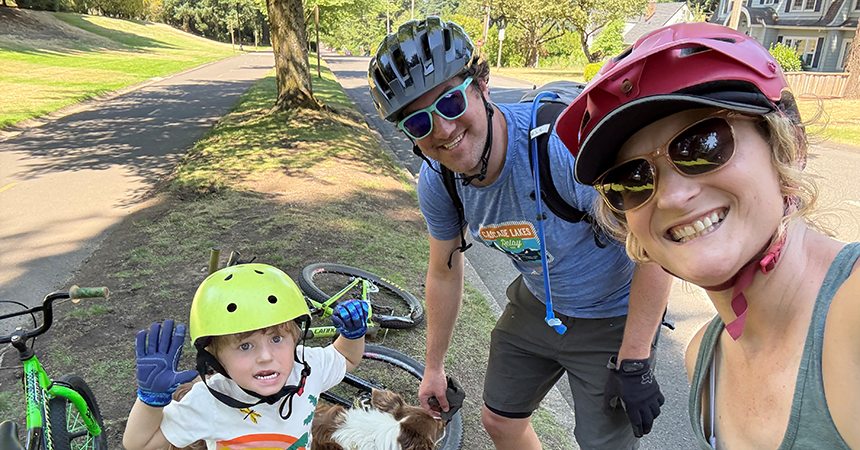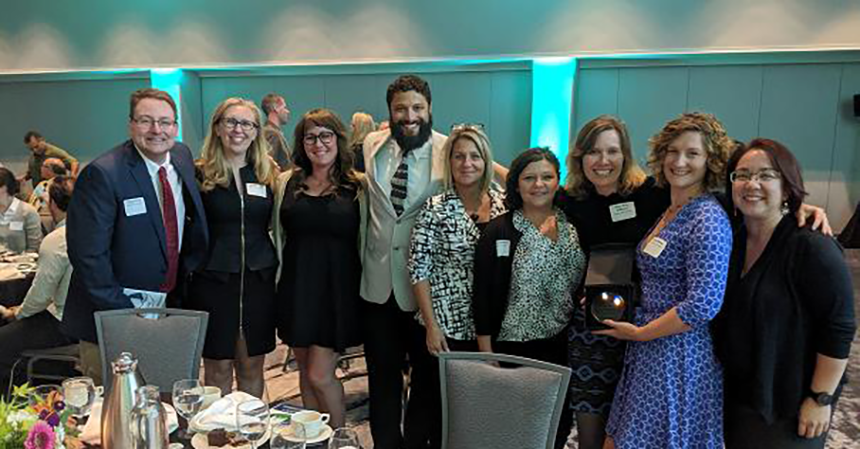
This is a part of a series of blog posts amplifying community voices. These views reflect the perspective of the Changemaker and do not necessarily represent those of Energy Trust.
After completing her undergraduate architecture studies in Washington, D.C. in 2008, Rachel Maas rode her bike across the country, landing at University of Oregon where she then earned a Master of Architecture degree. She originally wanted to build hospitals, but a strong interest in sustainability took root while living in the Pacific Northwest, as another way design could help vulnerable people. She has worked at Central City Concern (CCC) for 14 years, first as a Building Efficiency Coordinator, then as a Sustainable Development Manager. Since 2023 she has been CCC’s Director of Climate Action, heading up a new department charged with advancing environmental justice initiatives that include community development, environmental health, disaster risk reduction, sustainable design, social justice and equity, renewable energy and resilience.
Did you have any early experiences that shaped your awareness of design, the built environment, or sustainability?
I grew up in Napa, Calif., and had a very talented artist for a mother. So, I found myself drawn to art and design early on, which led me to architecture. I graduated from the Catholic University of America with my B.S. in Architecture in 2008, after the mortgage crisis – when no one was hiring architects. That’s what inspired me to ride my bike across the country. The great outdoors and nature and the fragility of the environment made a big impression on me. I eventually landed in Portland, to attend the Master of Architecture Program at the U of O, which is where my interest in sustainability took off. I was drawn to architecture because I was fascinated with the ways that design and the built environment can impact the lives of vulnerable people. And with climate change being the biggest humanitarian challenge of our time, I knew that was all I really wanted to do with my life.
Were there any specific influences that informed your career path?
Sam Mockbee’s Rural Studio at Auburn University was a big, early inspiration, with its primary goal of creating sustainable housing and equity for those with few resources. I also volunteered at Architecture for Humanity starting in 2011, directing projects, which I loved. Their work made it clear that addressing social and humanitarian challenges in underserved communities includes addressing climate change.
What drew you to focus specifically on climate action within the homelessness and housing sector?
I did a practicum with CCC in 2011 working on their new Building Efficiency Project and fell in love with the people and their mission. I quickly felt very at home, so I stuck around and volunteered before they could eventually hire me as a real estate development project manager. Fourteen years later, I am officially in my dream job as a Director of Climate Action.
CCC is a perfect place to serve those in need while also keeping climate goals front and center. My sphere of influence here is more than it would be as an architect, and I find that really special. I can impact environmental challenges at every stage of development, whereas an architect sees a limited portion of project’s lifespan. I get to be part of the journey from early concept through the leasing process and beyond, influencing the ways the built environment affects the quality of life for our residents.
Rachel at CCC’s Henry Building Seismic Renovation and Historic Preservation Project in 2020.?She managed the project, which preserved 153 units of affordable housing, added 20 new units of housing.
What have you learned about addressing climate change? Has your approach changed over the years?
We have learned over the years that climate mitigation — conserving water and energy — is not enough. We need to include resiliency and adaptation. CCC is working toward decarbonization, which includes using solar energy in our buildings, and electrifying our fleet. Through a partnership with Forth Mobility, we are also providing electric carshare vehicles to residents at a subsidized rate, and are expanding soon to include e-bikes.
We have also been developing a Property Database and Risk Assessment (PDaRA) tool – in a partnership with Green Hammer – which we are using to assign risk scores to all our buildings for relevant climate hazards and developing strategies for addressing those risks.
What approaches have you developed to protect unsheltered individuals and your residents during extreme weather events?
CCC has an amazing homeless outreach program. During extreme weather events these teams meet folks where they are to provide water and connections to cooling centers and other services.
For folks living in CCC housing, we send multiple heat safety communications prior to a heat event with information about cooling centers and health services. We hand out ice water, provide transportation, and establish dedicated cooling zones in our buildings where possible.
Additionally, through PCEF’s Cooling Portland program, CCC has distributed nearly 700 heat pump air conditioners over the last few years, prioritizing CCC residents with medical vulnerability.
We are also currently building out Resident Readiness Guides — short pamphlets of building-specific instructions in case of fire, heat wave, flood, power outage, and other climate emergencies. The guides were developed in collaboration with our Tenant Advisory Committee, which is made up of residents from CCC housing.
What’s an example of a design choice that can make a big impact on quality of life for CCC’s residents?
From unit finishes to a building’s envelope, quality, high-performance materials make such a difference. In one building where we replaced single-pane windows with triple pane, residents reported that they were able to sleep soundly for the first time in years because of the improvement in thermal comfort and noise reduction.
Where do you see Central City Concern’s climate action work heading in the next 5-10 years?
Our goal is to achieve net zero carbon emissions by 2050, in alignment with Portland’s Climate Emergency Workplan, and we continue to move aggressively toward that promise. But it will depend on the policies at play and available funding. It’s more challenging with electric vehicle and solar tax credits ending in the next few years. We’ll be more dependent on grants. We will also need to build more creative partnerships to help us maximize impact with limited funding and stay on track toward our goals.
Rachel with CCC colleagues in 2019, when she received the Star Player Award from Housing Oregon, for her dedication and innovation in affordable housing.
What advice would you give to other organizations serving vulnerable populations who want to integrate climate action into their work?
It needs to be a priority for any organization serving the people impacted first and worst by climate change. Climate action and equity have to be embedded in every action and every job, and leadership needs to buy in. We have to think realistically about how climate change affects our missions, including how an increase in climate refugeeism will increase the number and complexity of care for homeless folks in our region, and how economic impacts of climate change threaten our financial stability and access to resources.
But start somewhere. Incremental changes can be transformative. Even if it’s one or two people doing the work to start (my department consists of me and an intern), that can really make a difference for the planet and the people we serve. Remember to celebrate your successes (even little ones) and then leverage those stories to rally partners and collaborators around you to amplify the work.
You don’t have to be an expert, and you don’t have to do it alone. There are plenty of subject-matter experts out there eager to effect lasting change and ready to partner with value-driven organizations. Signaling that your actions are aligned with your values through a commitment to climate action is a great first step!

Rachel biking with her son Owen, husband Jeff, and dog Grendel.


